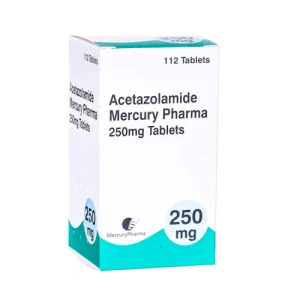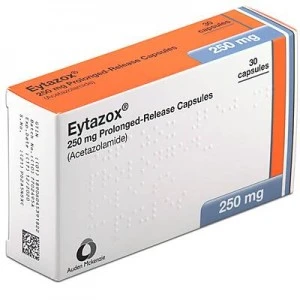Altitude Sickness
Altitude Sickness occurs when the lungs do not absorb sufficient oxygen. The amount of absolute oxygen absorbed by the body decreases as you ascend. Although the amount of Oxygen in the air is similar at higher altitudes, the air pressure is lower, which results in less oxygen being inhaled and absorbed. If the incline is too quick and fast, the body cannot adjust to the change in air pressure, which results in Altitude sickness.
Acetazolamide
- Reduce the symptoms of altitude sickness
- Diuretic and carbonic anhydrase inhibitor
- Remove bicarbonate from the body via urine
Eytazox
- Altitude sickness preventative
- Can help with common altitude symptoms
- Sent from a registered pharmacy
Altitude illness
Over the last few years, excursions to high-altitude destinations have increased significantly.
Climbing various Mountains, such as Mount Everest, or travelling the Inca Trail has increased in popularity. This is partly due to the increased accessibility of trail routes and guides.
Many people now undertake high-altitude excursions for various reasons, including the challenge itself or to raise awareness and money.
It can be physically and mentally challenging to undertake these types of excursions. At Prescription Doctor, we want you to be safe and advise you to conduct thorough research in conjunction with your physical training to ensure you are well-equipped for these challenges.
From a medical perspective, we want you to be aware of the possibility of Altitude Sickness and how it can manifest. It is essential to recognise the symptoms of altitude sickness to implement measures that treat and prevent potentially life-threatening complications.
What is altitude sickness?
Altitude sickness occurs when the lungs are unable to absorb sufficient oxygen. The absolute oxygen absorbed by the body decreases as you ascend higher. Although the amount of Oxygen in the air is similar at higher altitudes, the air pressure is lower, which results in less oxygen being inhaled and absorbed. If the incline is too quick and fast, the body cannot adjust to the change in air pressure, which results in Altitude sickness. Therefore, it is essential to climb steadily and rest when necessary to acclimate to the altitude. Everyone is different; your acclimatisation period may be quicker or slower than others. However, it is of primary importance to manage the climb at your own pace to protect yourself from Altitude Sickness.
Altitude sickness is an umbrella term often used to describe the various conditions associated with it.
This includes:
- Acute mountain sickness (AMS)
- High altitude cerebral oedema (HACE)
- High altitude pulmonary oedema (HAPE)
Acute mountain sickness (AMS)
AMS can occur, especially after 3000 m, when the ascent is too rapid or if you fly into areas of high altitude without allowing your body to acclimatise. Predisposing Heart conditions can increase the risk. However, there is a common misconception that gender, age, or physical fitness increases the risk.
Previous performance at altitude is a good indicator in determining the risk of AMS. It also allows you to understand the rate of incline your body can handle, thus enabling you to prepare for the challenge effectively.
The Lake Louise symptom guide is an effective tool for measuring the severity of Altitude Sickness. The guide describes AMS as the presence of headache and at least one other symptom, as listed below, after ascent to altitudes above 2500m.
AMS Symptoms:
- Fatigue
- Nausea/Vomiting
- Dizziness/Light-headedness
- Sleep Disturbances
High altitude cerebral oedema (HACE)
AMS can lead to the potential life-threatening HACE if left untreated, and ascent is continued. The continued lack of oxygen can lead to brain swelling; this is dangerous and can be fatal if untreated. It is difficult to diagnose as it can often be confused with other conditions, such as migraines. Medical assistance must be sought if HACE is suspected and treated promptly.
It precedes AMS and is characterised by the following:
- Altered coordination or consciousness
- Confusion
- Severe headache
- Vomiting
If any of the above symptoms occur, seek medical assistance immediately and consider moving to a lower altitude if necessary.
High Altitude Pulmonary Oedema (HAPE)
HAPE is a respiratory complication and can rarely occur in the absence of acute mountain sickness. It is usually developed when AMS is ignored or left untreated. It is difficult to diagnose, especially at high altitudes, and medical assistance must be sought if HAPE is suspected.
HAPE occurs due to an increase in fluid in the lungs and is associated with the following symptoms:
- Breathlessness, especially when resting or when lying flat
- Dry Cough
- Increased Fatigue
- Bluish Skin - cyanosis
- Bloody sputum
- Wheezing
- Tightness of the Chest
Risk of altitude sickness
The risk of altitude sickness increases at altitudes above 1500m above sea level. The risk increases if altitude ascent is increased too quickly, which does not enable the body to acclimatise to the increased level. HACE and HAPE rarely occur at altitudes lower than 2500 m; however, symptoms of AMS can still occur. It typically takes two days for symptoms to appear after ascent to altitudes greater than 3000m. It is essential to seek medical assistance immediately, as complications can be life-threatening.
High Altitude is divided into three subcategories, as detailed below.
| High altitude | Very high altitude | Extreme altitude | |
|---|---|---|---|
| Altitude level | 1500 m to 3500 m | 3500 m to 5500 m | Above 5500 m |
| Cities and Sites with High Altitude | Bogota Cuzco Quito Johannesburg | Everest Base camp Mount Fuji Peru Inca Trail The Alps Bolivia – La Paz Rocky Mountains | Mount Everest Mount Kilimanjaro K2 Mount Aconcagua Annapurna Circuit Caucasus Mountains |
Prevention
It is best to ensure you understand and are able to implement preventative measures to reduce the risk of Altitude Sickness. Previous experience in high altitudes does help. However, there is still a risk if your body cannot acclimatise itself.
The NHS and various travel health organisations suggest ascending gradually, especially above 3000 m, at a pace suited to your body. It can take up to two days for the body to acclimatise to the altitude increase. The general recommendations for safe ascent at any level of altitude are:
- Ascend gradually, taking rest days every four days to allow rest and acclimatisation
- Drink sufficient fluids
- Do not Drink Alcohol
- Do not smoke
- Eat High-Calorie meals
- Travel with an experienced guide
- Avoid direct flights to high-altitude sites
- Travel Insurance is recommended, especially if you are travelling above 3000 m
The additional recommendations for altitude levels above 3000 m are below:
- Avoid ascent of more than 600-900 m a day
- Do not ascend when symptoms are present; rest, treat the symptoms and allow your body to acclimatise.
If AMS symptoms are severe and last for more than 24 hours, they descend to a lower level.
Symptom treatment
Treatment options are dependent on the severity of the symptoms experienced. The Lewis Lake score can be used to ascertain the severity of the symptoms. The steps below should be considered if any symptoms are present in order to prevent further complications.
Follow these measures if the symptoms are not severe:
- It is important to rest and delay ascent for 24 hours, allowing the body to acclimatise itself
- Headaches - Paracetamol and Ibuprofen can help
- Sickness - Promethazine
- Manage symptoms. If they persist or worsen over 24 hours, seek medical assistance and descend by at least 500 m if possible. Do not ascend further until the symptoms desist.
A medication called Acetazolamide (Eytazox) can be given to help reduce the risk of Altitude Sickness. It is effective and is commonly used as a prophylactic treatment for travel to high altitudes. Our Doctors can provide a prescription for Eytazox after a quick and easy consultation.
References
© 2013 - 2025 Al Muhsineen Limited. All Rights Reserved. Registered Pharmacy: 34 Halliwell Road, Bolton BL1 8RL. Registered Office: 254 First Floor, Shearbrow, Blackburn, England, BB1 8DS







